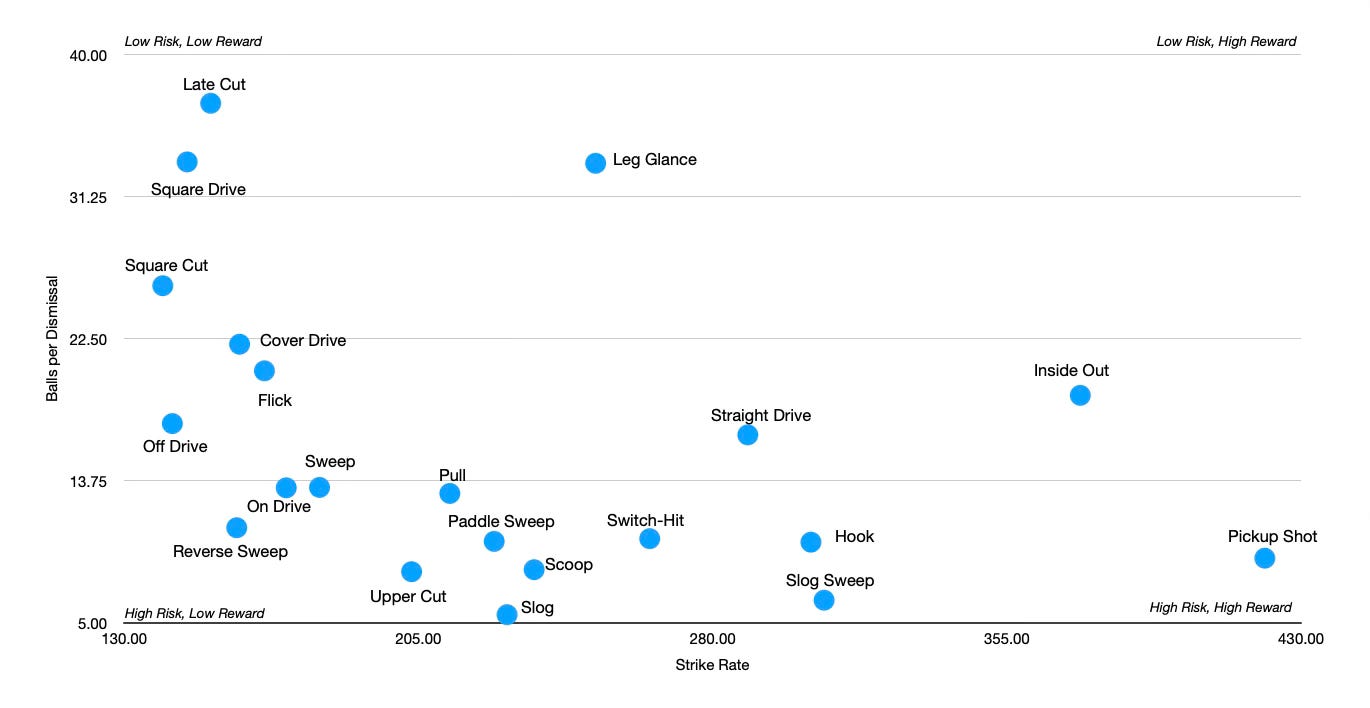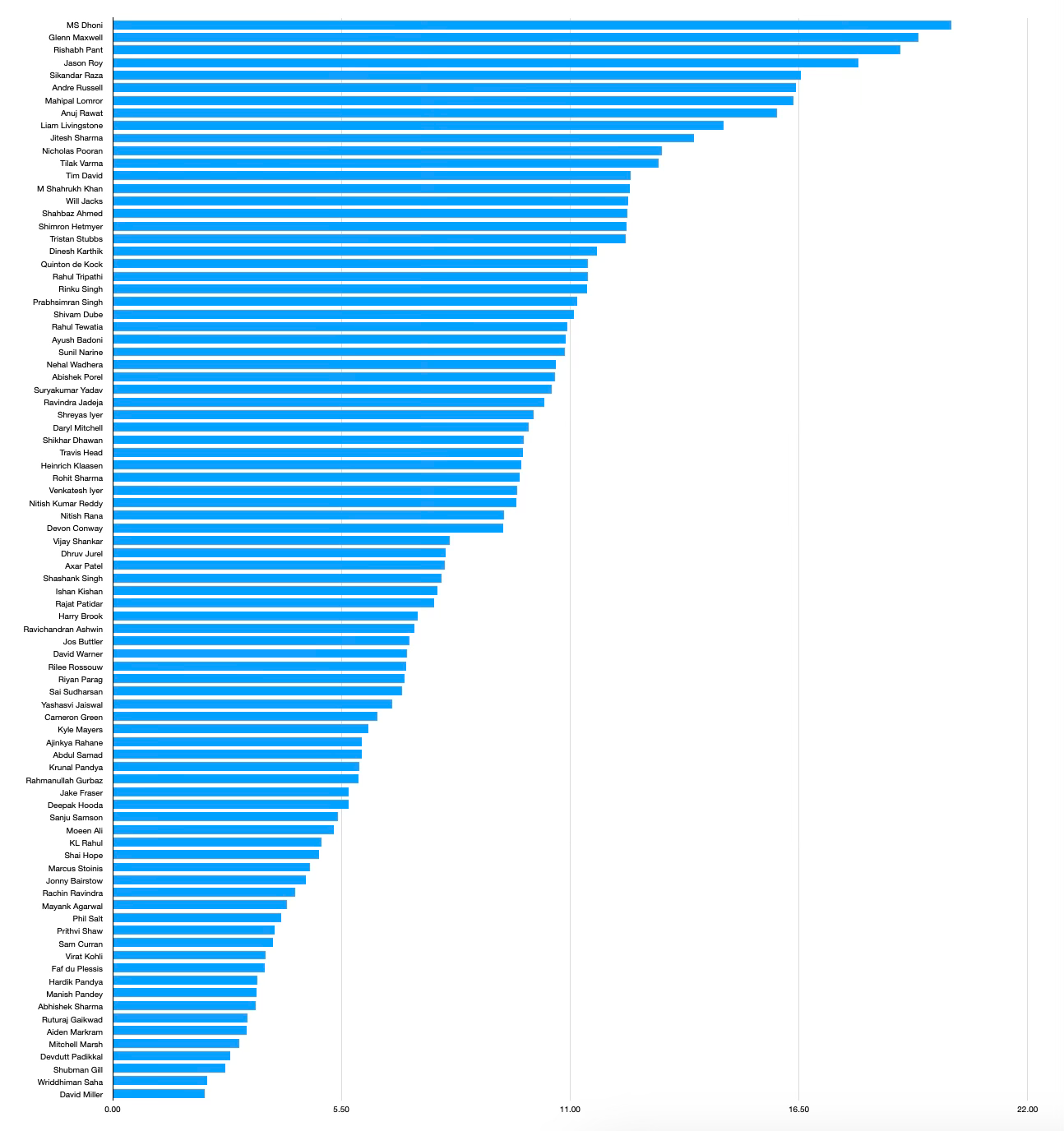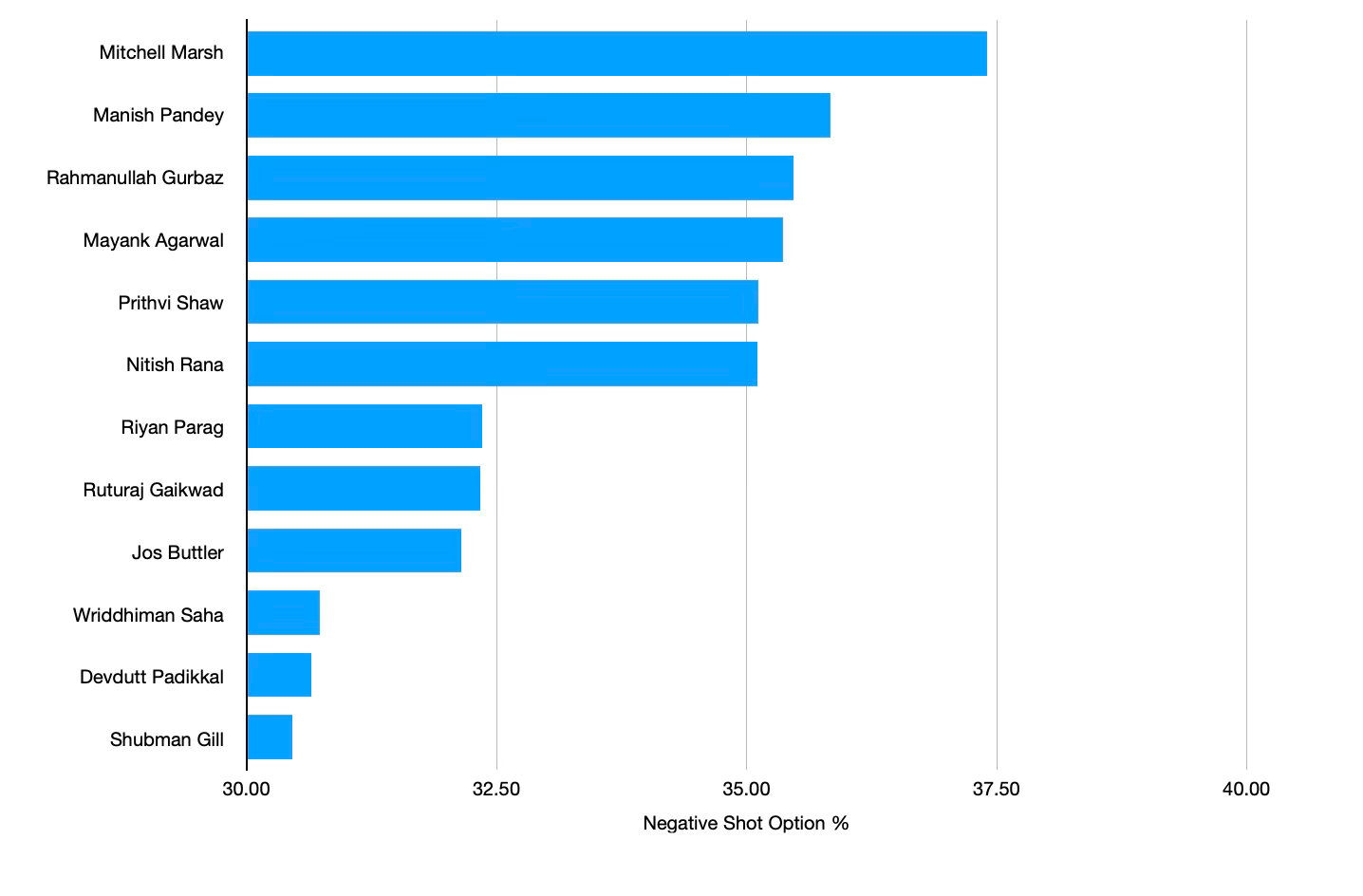Assessing Intent in the IPL
Detailed analysis on players and benchmarks
Cricket hasn’t scratched the surface yet of what is possible with data and analytics - one of my inspirations is to change that and show what can really be achieved.
This focus should cover both working with players (helping them to improve) as well as teams, plus also providing hugely valuable experience to the business side of cricket as well - all services which I can offer.
On that subject, before we get started, anyone interested in discussing how I can help their team with strategic management and data-driven analysis can get in touch at sportsanalyticsadvantage@gmail.com.
Moving on, most people think that data is basic metrics such as strike rate and batting average for players, and while these metrics are still important and do provide an extremely basic overview of a player’s ability, it doesn’t go into anywhere near enough depth to give comprehensive information on a player.
For example, what does a 130 strike rate represent? Is it good? Is it bad? How is that 130 comprised (e.g. does it contain a lot of attacking shots which aren’t well executed, or does it contain a lot of rotational options)?
If you can find a player who takes a lot of negative shot options when batting (or doesn’t play ultra-attacking shots very often) but executes those ultra-attacking shots superbly, and doesn’t necessarily have a negative mindset), you might find a batter with significant future upside which others haven’t yet realised - an under-the-radar, good value potential signing. I’ve actually worked in detail with a batter previously like this who since that now plays for his national team.
Conversely, if a batter has a low strike rate and struggles to execute attacking shots, their strike rate is always likely to be constrained - their upside simply isn’t going to be there unless they evolve considerable. That evolution is not quick, and cannot be achieved in one franchise tournament because the amount of technical work which a player can do in that short-term environment is pretty limited.
Clearly, all this information is critical for player recruitment, especially ahead of a major event such as the upcoming IPL mega auction. So, let’s have a look at overall numbers for batter’s attacking shot options across the last two seasons of the tournament (batters facing 120+ balls):-
Alert readers might realize at this point that the strike rates for these shots are all over 130, which seems higher than the average strike rate. That’s because I didn’t include a number of negative shot options on this analysis, such as push/work, defensives and leaves. Those options are pretty much impossible to score a boundary from, and drag a player’s strike rate down significantly - especially for those players who play them an above-average amount of the time. More on this later.
The risk/reward trade-off for all shots is very different. For example, shots such as leg glance, straight drive and the inside out shot have better risk/reward ratios than other shots - they have a higher balls per dismissal figure than other shots with a lower strike rate.
On the flip side, off drives and reverse sweeps would be classified closer to ‘high risk, low reward’ given their low strike rate but also below-average balls per dismissal numbers. I’ve often said that reverse sweeps are a good option for batters with one caveat - they’ve got to be very proficient at doing so. A number of batters reverse sweep poorly and should consider either working intensively on that shot or not using it as such a regular option.
The shots with the lowest balls per dismissal figures were slog-sweeps, slogs, upper cuts, scoops, hooks and the pickup shot - all had below 10 balls per dismissal. Slightly above 10 balls per dismissal was the switch-hit, paddle sweep and reverse sweep.
We can categorise these nine shots as ultra-attacking options, with the remainder of the shot options in the chart as attacking options, and the other non-boundary shots above as negative options. Here’s a look at the ultra-attacking shot option percentages for IPL batters facing 120+ balls across the last two years (zoom in for a detailed look):-
MS Dhoni leads the way in ultra-attacking shot percentages, with Glenn Maxwell and Rishabh Pant following closely behind. Conversely, four players possessed below 3% figures - David Miller, Wriddhiman Saha, Shubman Gill and Devdutt Padikkal. This quartet very rarely attempt high risk shots, which will have a natural curb on their overall strike rate.
Which IPL players are best at executing ultra-attacking shots across the last two seasons (sorted by strike rate)?
Albeit from a relatively small sample size of data, Abhishek Sharma is off the charts for executing ultra-attacking shots, hitting boundaries almost 80% of the time when he attempts these shot options. While the likes of MS Dhoni, Tristan Stubbs and Andre Russell are probably quite predictable in this list, a few surprising names are in there as well - such as Shubman Gill, Ruturaj Gaikwad and Virat Kohli - these players look very capable of increasing their strike rates if required in matches, although Gaikwad’s balls per dismissal figure playing these options would be a concern.
What about negative shot option percentages? These are interesting too - here are the 12 batters with the highest negative shot option percentages (those with 30% or more):-
Some players rarely look to play negative shots though - 13 players did so less than 15% of the time:-
Barely ever playing a negative shot was Sunil Narine and Jake Fraser-McGurk. This is basically a list of players who play an extremely positive style.
Is there a general relationship between attacking shot percentage (ultra-attacking and attacking combined) and strike rate for these batters facing 120+ balls?
Of course there is…
Look inside the lines at the top right hand corner - this shows all the players with 80%+ attacking shot percentage except for Ravindra Jedeja, who is the dot to the left - he was the only player with an 80%+ attacking shot percentage who struck below 150 across these last two IPL seasons.
Conversely only one player with a sub-70% attacking shot percentage could strike above 150 (Shubman Gill) with many striking below 130. Very few players could strike over 150 with a 70-75% attacking shot percentage either - the player on the far right towards the bottom right hand corner is Abhishek Sharma, whose numbers show quite how much strike rate potential he still has to realise. He could be a true superstar.
Three players stand out here - Jake Fraser-McGurk, Sunil Narine and MS Dhoni. These three could definitely be termed as ‘intent merchants’ with an attacking shot percentage of around 90% or above, and look at their strike rates - they are in line with this percentage. Two openers, and a finisher - even despite his advancing years, Dhoni still plays that particular role as well as anyone and shows the benchmarks required for success as a finisher.
On the subject of those benchmarks, here’s an overview of attacking shot % and the strike rate which derives from that metric:-
Remember, these numbers are derived from the players facing 120+ balls across these two seasons - generally the better batters in the IPL. Filtered out are tail enders and fringe players, hence why these numbers look a little inflated compared to the average strike rates and boundary percentages in the tournament.
We can see that as the attacking shot percentage rises, there’s a general increase in strike rate and boundary percentage, while there’s a very slight trade-off in balls per dismissal. Essentially, though, the players taking 85%+ ultra-attacking/attacking shot percentages are, on average, facing 20 balls and scoring 33(20), while those taking fewer than 70% of those positive shot options score, on average, similar to 31(22).
There is a real increase in boundary production once the ultra-attacking/attacking shot percentage increases above 80%, giving some initial insight into a percentage of options which players need to take in order to reach these stellar strike rates and boundary percentages.
Finally, earlier in this analysis I mentioned about finding a player who takes a lot of negative shot options when batting (or doesn’t play ultra-attacking shots very often) but executes those ultra-attacking shots superbly on the rare occasions they play them, you might find a batter with significant future upside which others haven’t yet realised - an under-the-radar, good value potential signing.
Abhishek Sharma hits all the criteria for this. He is unbelievable at executing ultra-attacking shots but rarely plays them - he has such a high ceiling. I fully expect SRH to retain him (they’d be mad if they didn’t) but if they do release Abhishek ahead of the mega auction, he should be one of the most sought-after players across the entire event.
The likes of Phil Salt, Rahmanullah Gurbaz and Rajat Patidar also have potential from this perspective, and could be astute pick-ups for teams if they are available in the mega auction in a few months time.
Anyone interested in discussing how I can help their team with strategic management and data-driven analysis, or contribute to any media work, can get in touch at sportsanalyticsadvantage@gmail.com.
Raw data sourced from Kadamba/Cricket 21.







